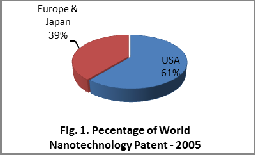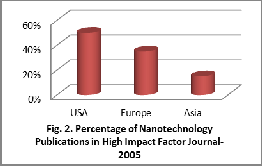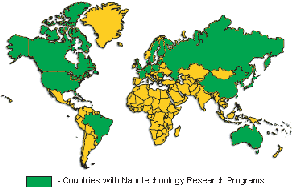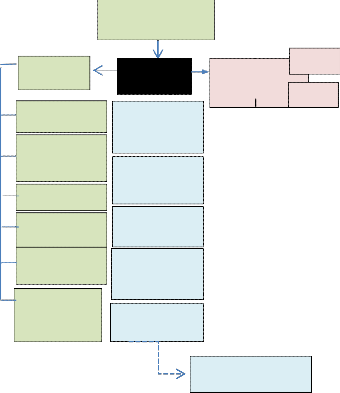

International Journal of Scientific & Engineering Research, Volume 4, Issue 11, November-2013 179
ISSN 2229-5518
Abstract— Global Economy and life style of human being will be changed in coming decade due to the enormous impact of nanotechnology in manufacturing, electronics, IT, communications technology and all other industry which have the potentials to change every part of our lives making previous technology redundant and leading to applications which could not have been developed or even thought about. Nanotechnology development was not pursued in Bangladesh following a specific growth model and there are few overall strategies that can be identified. This article attempted to understand the nanotechnology and its consequences, scopes and opportunities which we have and have not and explained also the possible strategies for nanotechnology research and application in Bangladesh. The information and strategies had been developed through some internet based literature reviews and the recent government initiatives for nanotechnology development in Bangladesh. In conclusion, the article suggests for a harmonized and balanced strategy with a whole hearted efforts from scientists, researchers, academicians, environmentalists, economists, business community and government officers to come together to make a roadmap for nanotechnology research and development in Bangladesh.
Index Terms— Bangladesh, Consequences, Government, Implications, Nanotechnology, Policy, Risk, Strategic framework, Strengths, Weakness.
—————————— ——————————
1 An Overview On Nanotechnology
HE evolutionary history of technological development is shaping the potentiality of human being all over the world. The technologies invented in different ages of science have changed the social and economic scenario in the development history of human being. However, there arose tension in human in the question of benefit or risk of the tech- nology. Now, technology comes to the nano size- nanotechnology. It is so new, so small; we can't see it - even with a light microscope [1]. This technology is involved in manufacturing the nanoparticles with the new and functional properties using the nanosystems to create a huge database which is applicable in the vast array of disciplines of physics, engineers, biologists, chemists and so on [1]. Dr. M.C. Roco, [2] Chair, NSET & NSTC, USA quoted nanotechnology as “Working at the atomic, molecular and supramolecular levels, in the length scale of approximately 1–100 nm range, in order to understand, create and use materials, devices and systems with fundamentally new properties and functions because of their smallstructure.[Definitionon www.nano.gov/omb_nifty50.htm (2000)].” Nano particles are nonscalable outside of the nm domain having the properties and performances with unique phenomena and functions and capable to control over or manipulate any matter for changing the properties and functions with an integration along into a larger system. " Small Wonders: The World of Nano science,"-
is a lecture of Nobel Prize winner Dr. Horst Störmer [3] stated
————————————————
• Dr. Masuma Parvin is currently working in the Ministry of Science & Tech- nology, Government of the Peiple’s Republic of Bangladesh, PH-88 02
9555011, Mobile- 88 01819141258. E-mail: acmasuma@gmail.com
‘nanoscale is the first point where we can assemble something
-- it's not until we start putting atoms together that we can
make anything useful ”.
Dr. M.C. Roco [2] stated four generations of nanotechnology in the lecture of 10- 20 years vision of Nanotechnology in U.S. of Research and education and risk governance as follows-
1. 1st Generation: Passive nanostructures (Ex: coat-
ings, nanoparticles, nanostructured metals, poly- mers, ceramics)
2. 2nd Generation: Active nanostructures (Ex: tran- sistors, amplifiers, targeted drugs, actuators, adap- tive structures)
3. 3rd Generation: Systems of nanosystems (Ex: guided molecular assembling; 3D networking and new system architectures, robotics, supramolecu- lar)
4. 4th Generation: Molecular nanosystems (Ex: mol- ecules as devices/components ‘by design’, based on atomic design, hierarchical emerging functions, evolutionary systems).
US has about 61% of world Nanotechnology Patent, W. Eu- rope and Japan is in 2nd and 3rd respectively (Fig. 1, 2). USA has planned for 20 years with specific mission and vision and it is anticipated that by 2020 [2] and USA nano-related busi- ness will reach the trillion dollar mark. The efforts led by the United States strategic nanotechnology started since 1998’s. US Congress approved the ‘21st Century Nanotechnology Re- search and Development Act’ to further institutionalise of nano research [4].
IJSER © 2013 http://www.ijser.org
International Journal of Scientific & Engineering Research, Volume 4, Issue 11, November-2013 180
ISSN 2229-5518


Data Source: Dr. M.C. Roco, Chair, Subcommittee on NSET, USA
2004 [2]

Europe, Japan, China, India, Philippines, Thailand, Indone- sia, Pakistan, Taiwan, Singapore, Turkey, Australia, Africa, Srilanka have already began their efforts for nanotech research and policy formulation from the government initiatives to invest to the science. At the end of 2001, at least 30 countries had initiated national nanotechnology programs (Fig. 3) [5].
Fig. 3. Countries with nanotechnology research programs
Source: Small Wonders, Endless Frontiers: A Review of the National Nan- otechnology Initiative http://www.nap.edu/catalog/10395.html, Copyright
© National Academy of Sciences, USA. All rights reserved.
Japan has allocated more than USD 6.5 billion , followed by USA, Europe and China around USD 6.0 billion, USD 4.8 bil- lion and USD 3.2 billion, respectively from 2006 to 2010 (Fig. 4)
Data source: Attachment paper of “International Workshop on Nano- technology” in Indonesia, 2-4th October, 2013
Due to commercialization of different types of nanoproducts there is a long procession of the industries all over the world with great acceleration of nanotechnology. At the commercial level, area of nanotechnology occupied in three major industry sectors, e.g., materials and manufacturing, electronics and health care and life sciences (pharmaceutical applications). According to the Woodrow Wilson International Center for Scholars’ Project on Emerging Nanotechnologies (2009), there are more than 1000 company-identified nanotechnology prod- ucts on the market, the majority being produced by companies based in USA. USA, including Germany, japan, Korea and China are also producing the nanoproducts commercially in health and fitness, home & garden, electronics & computers, food & beverage, automotive, cross cutting, appliances and goods for children etc [5].
2.1 New nanoproduct development & its application [6] Nanotechnology affects all materials used in daily use or in industrial products namely, ceramics, metals, polymers, and biomaterials etc. Current commercial applications include Sunscreens, (which use nanosized zinc oxide particles to ab- sorb and reflect UV rays), Self-cleaning windows (coated with nanoparticles, sun shines on these windows, a chemical reac- tion is triggered which breaks down dirt. Rain, instead of forming droplets, will spread evenly over the panel and wash away the broken down dirt), Bouncy tennis balls (coated in nanosized material. A molecular barrier is formed by the tiny particles that trap air molecules making the balls extra bouncy) and also nanoelectronics and computer technology (nano circuits will enabling the computer & laptop far greater speeds and longer life), nanoparticles for environment and energy (e.g., nanometer sized solar cells), etc.
High quality research and development will improved knowledge and quality of life style, and may be it will ensure environment protections to some extends regarding energy savings. New types industrial revolution will change the so-
IJSER © 2013 http://www.ijser.org
International Journal of Scientific & Engineering Research, Volume 4, Issue 11, November-2013 181
ISSN 2229-5518
cial life and the approach of human resource development will create new scopes of jobs in different research institutions and in industries also.
2.3 New settings of goals for research & Development The science of Nanotechnology is intrinsically relates to the research in more basic and unifying science and education which leads to higher efficiency processes and novel products like molecular medicine in health and fitness, nano circuits in electronics & computers etc. There is much possibility to ex- tend the limits of sustainable development and increase co- herence integration of science and technology policies in a country.
3. WEAKNESS AND STRENGTH OF NANOTECHNOLO- GY RESEARCH & DEVELOPMENT IN BANGLADESH
The Ministry of Science & Technology, Government of Bang- ladesh, has announced the Science & Technology Policy-2011, National Biotechnology policy -2012 with the provision of na- noscience research. The ministry is implementing also re- search and development projects through 6 autonomous bod- ies and they have few initiatives to start with the nanotechnol- ogy in our country.
According to the R&D policy Bangladesh government is funding for higher study fellowship programmes, small and grand funding to the researchers of the government and pri- vate institutions through peer review committees who are identifying the projects specially which are socioeconomically benefited for Bangladesh.
Bangladesh Government has built the maximum facilities for nanotechnology research in Bangladesh Atomic Energy Commission (BAEC) and Bangladesh Council of Scientific and Industrial Research (BCSIR) and National Institute of Biotech- nology (NIB) and one documentation center- Bangladesh Na- tional Scientific and Technical Documentation Centre (BANS- DOC). At least 30 types of machineries which can support for nano-system are available in BCSIR only and BAEC, NIB are also enriched with machineries support. They are already be- ing engaged for development of some nano particles in the area of structural materials, agricultures, packaging, biomedi- cal & dental applications, cutting tool, implants, electronic materials, electronic ceramics, magnetic devices, solar cell, solar energy, fabrics, energy & environment pollution control, photonics, chemical & biosensor etc. However, this number of products has not been trailed for application research due to lack of laboratory of application research facility. In our coun- try, at least 50 researchers from 11 government and nongov- ernment institutes/universities are involved with the nanopar- ticle research in 20-25 fields of nanotechnology through na- tional collaboration7.
The major institutions for nanoparticle research in Bangla- desh are BCSIR, BAEC, NIB, Bangladesh University of Engi-
neering and Technology, Khulna University of Engineering and Technology, Chittagong University of Engineering and Technology, University of Dhaka, Rajshahi University, Chitta- gong University, ICDDRB and Agricultural University etc. There is a hope for National Nanotechnology Research Centre (NCR)/National Institute for Nanotechnology (NIN) from to the declaration of Honourable Prime Minister of Bangladesh for advancement of nanotechnology research and develop- ment.
Very recently Bangladesh Government has declared an in- dustrial park of Active Pharmaceutical Companies (API) Cen- tre which will be a mile stone for the nanotech research in Bangladesh in pharmaceutical sector. At the present time there are few research activities in the Pharma companies as they are thinking to expend on nanotechnology research for API or other Pharma products or medicine etc but this initiatives will increase product cost which would may not be profitable for our Pharma business.
There some questions below find the present situation of nanotechnology in Bangladesh:
IJSER © 2013 http://www.ijser.org
International Journal of Scientific & Engineering Research, Volume 4, Issue 11, November-2013 182
ISSN 2229-5518
for a plan for our national nanotechnology strategy in this sit- uation. Strategies for technology development generally come
from the social or national or global need or any national cri- ses according to the fiscal ability. Some simple suggestions from a singular point of view of a scientist or a policy maker should not be reflected on a critical national strategy as it may not be suitable, so that in this study some related issues have been identified only.
Maximum answers of the related questions are no/not known. However, there is nothing to be disheartened as we are starting with nanotechnology research. Let’s try to think
There is no specific model for the strategy of the nanotech- nology development in the world. India identified focusing
area, namely health, energy and environment. They have also formed a three tired structure where academic institutes served as knowledge generation bodies and industry and pro- fessional associations served as knowledge application bodies. In parallel, India established a two-pronged approach-human resource development via training, academic programmes and establishment of nano institutes, producing expert labour force for future nano-industries [4].
Brazil and India pursued the regional and international col- laboration. Brazil took gradual and structured measures, ini- tially it funded four proposals followed by establishment of national centres of excellence [4]. Philippines has just jumped to the nano-tech development using a decade long nanotech- nology roadmap in 2009. The roadmap outlined the strategies namely, assessment of global need; identification of national academic; technical and financial strength; and pursue nano- related research and commercialization in five specific areas, i.e., information and communications technologies, food and agriculture, energy, health and environment [4].
4. SOME KEY POINTS FOR DEVELOPMENT OF STRA- TEGIC FRAMEWORK FOR NANOTECHNOLOGY IN BANGLADESH “[2],[4],[8]”
4.1 In Bangladesh, our research & development budget of government is million dollars for all types of research and development, not billion or trillion. However, it is, we should expend according to our FY ability for nanotech- nology research and development. Bangladesh can follow a hybrid policy-combining human resource development and in parallel, research capability build up for nanoparti- cle production and application research; commercialization of nano-enabled products. It may also specify one or two or three sector/sectors of energy, environment, health and agriculture, garments, ceramics, cement etc for nanotech- nology research and development to start according to its FY budget ability. Human Resource Development plan for nanotechnology development may plan targeted the model as follows (Fig. 5).
IJSER © 2013 http://www.ijser.org
International Journal of Scientific & Engineering Research, Volume 4, Issue 11, November-2013 183
ISSN 2229-5518
quirements, the risk factors, regulatory structure, engage- ment of the stakeholders and diffusion of the technology to
the society.![]()
Cur- ricu- lum Devel- op-

NT Training Programmes for Professionals only
NT Post Graduation
Education
NT Graduation
Education
NT Undergraduate
Education
Short & Long
Short Term
4.7 Consideration of the comprehensive and responsive health and environmental risks, material safety data sheet (MSDS), proper documentations, publications,
timely reporting to the government all together are im- perative in policy formulation.
4.8 The regulatory authority should be dynamic and review
the performance for new fund creation, international and regional cooperation, market analysis, entrepreneurship,
NT Elementary
Education
Fig. 5. Human Resource Development Framework for
NT
4.2 Development of the policy in targeting with a mission and vision and a set of timelines in the FY budget of science & technology ministry to increase investment in development of competitive R&D infrastructure, interdisciplinary educa- tion and training system.
4.3 Sufficient funding for nanotech development is a critical
of the actors regarding nanotechnology. Their activities should be channelized in a balanced and harmonized way to receive a sustainable development for the society.
4.9 Bangladesh can use the potential of some new nano-
researchers who are working as experts in different or- ganizations in abroad.
4.10 All the possible activities of nanotechnology authority are
enlisted in Fig.6.
NT Policy For- mulation- Short
issue in our FY budget. So performance evaluation regard-
ing publications, infrastructures and other nano-related ac-
tivities should be a considerable issue for the autonomous bodies and academicians who are responsible for devel-
Time lines for achieve- ment in FY Budget
term & Long
Term
Fund
Creation
opment and application research of nanotech particles al- together with entrepreneurship with industries, technology transfer and innovation and, contribution to economic growth to meet up the social needs.
Research- Social
Impact, National
& Global Market
Strategy
Health & Envi-
ronment safety
Risk management
Capacity
Building
4.4 Risk of restructuring of existing industrial configuration
and investing the production cost for new forms of nano- technological demand , costing, capability, collaborative arrangements etc.
4.5 Deliberation of a strategic government policy for develop- ment of own expertise, assessment of market signals which one is weak or strong and setting the social priority or so- cial goals of the nanotechnology development and re- search.
Target setting for NT Industry (Selective: Ceram- ic/Local Gar-
ments/Cement) NT Regula- tory Author-
ity and
Activities
Entrepre- neurship develop-
Human Resource, Institution, lab, machineries etc.
Publications
Documenta- tion & Patent
NT Product
Toxicology
& MSDS
4.6 Nanotechnology research, development, application to the
society depends largely on Government and so that gov-
ernment will evaluate the in depth implication to the social
& political situation of this country. For this reason, for clear strategic position of the government and integrated framework it needs to address the present knowledge gaps among policy makers, politicians, economists, industrial- ists, scientists, academicians, skilled manpower and other stakeholders of nanotechnology to govern the strategy concerning to basic knowledge of nanotechnology, skill re-
ment
NT Devel- opment Research
NT Appli-
cation
Research
NT Report to
Government
NT Reporting on E documentation, Monitoring, Evalua- tion, Publications, Patent, Timely Sur- vey Report, Follow- up Report, etc
National, Regional & International Collaboration
IJSER © 2013 http://www.ijser.org
International Journal of Scientific & Engineering Research, Volume 4, Issue 11, November-2013 184
ISSN 2229-5518
Fig. 6. Nanotechnology Authority and its possible activities
5. NANO INITIATIVES OF BANGLADESH GOVERN- MENT [7]

![]()
![]()
![]()

The key players engaged in nanotechnology in Bangladesh are given in the following Fig.7.
Ministry of Science & Technology (MOST)
complex nanotechnology system, improper safety measure for the stakeholder, lack of coordination of the institutes (e.g. ac-
ademic/research organisations/industries), carelessness of the scientists, improper data base system, nonprofessional or un- skilled manpower- all, or one of all the factors may shatter down the success of nanotechnology research, development and application in any area of the world.
7. CONCLUSION
Bangladesh Government is aware of human rights of access to knowledge and welfare, human integrity, dignity, health and safety which are interrelated to a balanced and equitable R&D
Policy makers
Ministry of
Industry
Ministry of Fisheries and Animal
Ministry of F d Ministry of
Education
Ministry of
Agriculture
Ministry of Environment and Forestry
NT Committee
Establishment of NT Re- search Centre
Identification of specific NT Research Area
Resource Per- son Identifica-
i
Public Benefit Identification from NTRC
Reporting to
MOST
Knowledge Generation Group
Knowledge Application Group
BCSIR BAEC NIB
NT Policy
Formulation
BUET DU
nanotechnology investment. It is also a major concern for hu-
man resource development, environment protection and social
life improvement as long term issues. The harmonization of all complex issues in a framework for sustainable development towards nanotechnology research for country economy is an inevitable issue. Government should way out its roadmap for a short term and long term nanotechnology framework with a view to a vast array of economic development, human re- source development, education, ethics, moral, regulatory ac- tivity, environment & health hazards and other social, national and international aspects immediately.
8. 8. Acknowledgment
I would like to express my special gratitude and thanks to Dr. Navid Saleh, Assistant Professor, University of Texas, Austin, USA, his efforts over telephone conversation inspired me to complete this articles.
My thanks and appreciations also go to my senior colleague
Dr. Golam Mostofa, Deputy Secretary who is coordinating the nanotechnology policy developments for Bangladesh for his cordial approach in collection of some government documents
Fig. 7. Government Initiatives in Nanotechnology in Bangla-
desh
6. UNEXPECTED CONSEQUENCES AND RISKS
Every new technology has both good or bad consequences and risk in terms of understanding level of the people of a society regarding the new technology. Its success and failure largely depended on the foresights of the majority people of a society, adaptation capability, economic status, lifestyle, attitude to the technology, faulty government planning regarding the tech- nology etc. So that, many people are afraid of the consequenc- es of new technologies and products. In the developing coun- try there must be knowledge gap among different classes of the societies. In case of nanotechnology, there requires indus- try restructuring for adaptation with the technology. The ques- tion of capabilities and risk to handle the nanoparticles in re- search area or industry level or user level may endanger the
on nanotechnology committee of the Ministry of Science and
Technology.
At last, but not least, I am thankful to my supervisor, Mr. Awolad Hossain Khan, Deputy Secretary of the Ministry of Science & Technology, for his inspiration to write up this paper on nanotechnology.
9. References
[1] Center for Responsible nanotechnology, “A brief history of Nanotechnology” © 2002-2008 Center for Responsible Nanotechnology TM http://crnano.org/index.html
[2] Dr. M.C. Roco, Nanotech planning in US, Lecture on Nano technology in U.S. - Research and education and risk gov ernance October 12, 2004
IJSER © 2013 http://www.ijser.org
International Journal of Scientific & Engineering Research, Volume 4, Issue 11, November-2013 185
ISSN 2229-5518
[3] The world of nanotechnology at http://science.howstuffworks.com/nanotechnology1.htm
[4] Article “Bangladesh path forward in Nanotechnology”
written by Dr. Navid Saleh in the Daily Star 13th January
2013 at http://archive.thedailystar.net/newDesign/news-
details.php?nid=266227
[5] Small Wonders, Endless Frontiers: A Review of the Na tional Nanotechnology Initiative http://www.nap.edu/catalog/10395.html, Copyright © Na tional Academy of Sciences, USA. All rights reserved.
[6] Why is nanotechnology so important? At http://www.rsc.org/get-involved/hot- top
ics/Nanotechnology/importance-nanotechnology.asp
[7] Meeting Minutes of Nanotechnology Committee in the
Ministry of Science & Technology, Bangladesh on the date
19.06.2013. (Unpublished documents)
[8] T E R I. 2010
Nanotechnology development in India: building
capability and governing the technology [TERI Briefing
Paper], supported by IDRC, Canada
IJSER © 2013 http://www.ijser.org